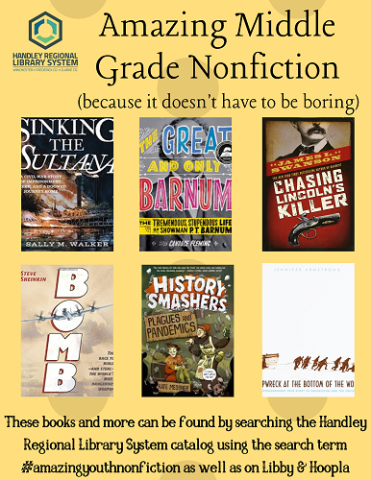
Our Middle Grade book spotlight this week is on more amazing nonfiction titles! It can be easy to think that nonfiction is boring but these titles are the complete opposite of that thought; we have everything from books about outer space and animals to history through other lenses and an adventure that is so unbelievable you will think it is fiction but it isn’t; you will not even realize you are reading nonfiction because they are that good. These books and more can be found by searching the catalog using the search tag #amazingyouthnonfiction as well as on Libby and Hoopla. Check back next week for a new Middle Grade book spotlight and if you have any book suggestions, please let us know!!
Sinking the Sultana by Sally M. Walker--Explores the history of a disaster on the Mississippi River on April 27, 1865 when the "Sultana," a steamboat in Vicksburg, Mississippi, exploded and killed over 1,500 passengers. The "Sultana" had been packed with too many passengers and necessary repairs had not been done in order for the greedy captain to make as much money as he could from the newly released Union soldiers. Examines what went wrong and what could have been done in order to avoid the tragedy.
The Great and Only Barnum by Candace Fleming--You may not have lived in the times of P.T. Barnum, but reading this book will make you feel as if you paid your ticket to see the greatest show on earth. Fleming's biography chronicles the life of Phineas Taylor Barnum, the man who created Barnum's American Museum and later the Barnum and Bailey Circus. Barnum was born poor in 1810, but through sheer determination and an impulsive instinct for what the public wanted to see, he made it big and became one of the first 19th-century millionaires. Fleming includes both the good and bad sides of Barnum and provides scintillating text, rich photographs, engravings and illustrations that depict his era.
Chasing Lincoln’s Killer by James Swanson--This adaptation of the original expertly details John Wilkes Booth's loyalty to the South and his determination to rid the Union of Lincoln's presence any way he could. He originally planned to kidnap Lincoln and hold him hostage. Booth's co-conspirators attempted and failed to assassinate Secretary of State William H. Seward as Lincoln lay dying, but they expertly helped Booth evade arrest for 12 days.
Bomb by Steve Sheinkin--It was in December of 1938 that German chemist Otto Hahn experimented with uranium. Almost by accident, he found that uranium atoms split when put next to radioactive material. When word got out, physicists and chemists across the United States, Great Britain, Germany, and the Soviet Union raced to find a way to make a bomb by splitting the atom. The KGB installed their spies, physicists were hidden away in secret laboratories in deserts like Los Alamos, and the Allies began searching for and destroying German heavy-water manufacturing plants.
History Smashers: Plagues and Pandemics by Kate Messner--Relates facts and information about assorted historic and recent plagues and pandemics aimed at clearing up preconceived notions and offering further insight, such as how the diseases spread, how governments often made the problem worse, and the challenges of treating the diseases. Includes sidebars, comics, illustrations, a glossary, and further resources.
Shipwreck at the Bottom of the World by Jennifer Armstrong--Describes the events of the 1914 Shackleton Antarctic expedition when, after being trapped in a frozen sea for nine months, their ship, Endurance, was finally crushed, forcing Shackleton and his men to make a very long and perilous journey across ice and stormy seas to reach inhabited land.